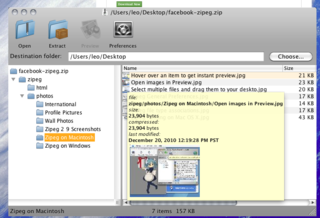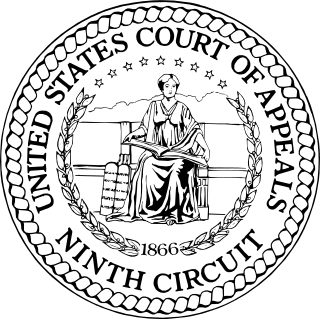
File Explorer, previously known as Windows Explorer, is a file manager application that is included with releases of the Microsoft Windows operating system from Windows 95 onwards. It provides a graphical user interface for accessing the file systems. It is also the component of the operating system that presents many user interface items on the monitor such as the taskbar and desktop. Controlling the computer is possible without Windows Explorer running.
An image viewer or image browser is a computer program that can display stored graphical images; it can often handle various graphics file formats. Such software usually renders the image according to properties of the display such as color depth, display resolution, and color profile.

In computing, a file dialog is a dialog box-type graphical control element that allows users to choose a file from the file system. File dialogs differ from file managers as they are not intended for file management, rather they are intended for the opening and saving of files. Before file dialogs, most programs requested files as a command line argument or as an exact file path. Others required users to select a file from the file manager. A file dialog allows an application to access individual files in a standardized and secure way, with the user in control of what files to share with the application. Mobile phone operating systems lack file selection dialogs. Instead users are expected to give applications control over the whole file system.
Media RSS (MRSS) is an RSS extension that adds several enhancements to RSS enclosures, and is used for syndicating multimedia files in RSS feeds. It was originally designed by Yahoo! and the Media RSS community in 2004, but in 2009 its development has been moved to the RSS Advisory Board. One example of enhancements is specification of thumbnails for each media enclosure, and the possibility to enclose multiple versions of the same content.
Design rule for Camera File system (DCF) is a JEITA specification which defines a file system for digital cameras, including the directory structure, file naming method, character set, file format, and metadata format. It is currently the de facto industry standard for digital still cameras. The file format of DCF conforms to the Exif specification, but the DCF specification also allows use of any other file formats.
On Microsoft Windows operating systems, starting with the Internet Explorer 4 Active Desktop Update for Windows 95 and 98, a thumbnail cache is used to store thumbnail images for Windows Explorer's thumbnail view. This speeds up the display of images as these smaller images do not need to be recalculated every time the user views the folder.

Adobe Bridge is a free digital asset management app made by Adobe Systems and first released with Adobe Creative Suite 2. It is a mandatory component of Adobe Creative Suite, Adobe eLearning Suite, Adobe Technical Communication Suite and Adobe Photoshop CS2 through CS6. Starting with Creative Cloud, however, it has become an optional component downloaded via Creative Cloud subscription.
FastStone Image Viewer is an image viewer and organizer for Microsoft Windows, provided free of charge for personal and educational use, as of version 7.0. The program also includes basic image editing tools.
Tag Image File Format/Electronic Photography (TIFF/EP) is a digital image file format standard – ISO 12234-2, titled "Electronic still-picture imaging – Removable memory – Part 2: TIFF/EP image data format". This is different from the Tagged Image File Format, which is a standard administered by Adobe currently called "TIFF, Revision 6.0 Final – June 3, 1992".
The Open Packaging Conventions (OPC) is a container-file technology initially created by Microsoft to store a combination of XML and non-XML files that together form a single entity such as an Open XML Paper Specification (OpenXPS) document. OPC-based file formats combine the advantages of leaving the independent file entities embedded in the document intact and resulting in much smaller files compared to normal use of XML.
Quick Look is a quick preview feature developed by Apple Inc. which was introduced in its operating system Mac OS X 10.5 Leopard. The feature was announced at the Worldwide Developers Conference on Jun. 11, 2007.

PCMan File Manager (PCManFM) is a file manager application developed by Hong Jen Yee from Taiwan which is meant to be a replacement for GNOME Files, Dolphin and Thunar. PCManFM is the standard file manager in LXDE, also developed by the same author in conjunction with other developers. Since 2010, PCManFM has undergone a complete rewrite from scratch; build instructions, setup and configuration have changed in the process.

Zipeg is an open source free software that extracts files from compressed archives like ZIP, RAR, 7z and others, some of which are rarely used types. Zipeg works under Mac OS X and Windows. It is best known for its file preview ability. It is incapable of compressing files, although it is able to extract compressed ones. Zipeg is built on top of the 7-Zip backend. Its UI is implemented in Java and is open source.

Kelly v. Arriba Soft Corporation, 280 F.3d 934 withdrawn, re-filed at 336 F.3d 811, is a U.S. court case between a commercial photographer and a search engine company. During the case ownership of Arriba Soft changed to Sorceron, the operator of the Internet search engine Ditto.com. The court found that US search engines may use thumbnails of images, though the issue of inline linking to full size images instead of going to the original site was not resolved.

Thumbnails are reduced-size versions of pictures or videos, used to help in recognizing and organizing them, serving the same role for images as a normal text index does for words. In the age of digital images, visual search engines and image-organizing programs normally use thumbnails, as do most modern operating systems or desktop environments, such as Microsoft Windows, macOS, KDE (Linux) and GNOME (Linux). On web pages, they also avoid the need to download larger files unnecessarily.

Perfect 10, Inc. v. Amazon.com, Inc., 508 F.3d 1146 was a case in the United States Court of Appeals for the Ninth Circuit involving Perfect 10, Inc., Amazon.com, Inc. and Google, Inc. The court held that Google's framing and hyperlinking as part of an image search engine constituted a fair use of Perfect 10's images because the use was highly transformative, overturning most of the district court's decision.

PhotoLine is a raster and vector graphics editor for Windows and Mac OS X. Its features include 16 bits of color depth, full color management, support of RGB, CMYK and Lab color models, layer support, and non-destructive image manipulation. It can also be used for desktop publishing.
PMView is a raster graphics image viewer, converter, and organizer with basic image editing capabilities. It was originally developed for OS/2 but is also available for Microsoft Windows.
High Efficiency Image File Format (HEIF) is a file format for individual images and image sequences. It was developed by the Moving Picture Experts Group (MPEG) and is defined by MPEG-H Part 12. The MPEG group claims that twice as much information can be stored in a HEIF image as in a JPEG image of the same size, resulting in a better quality image.









